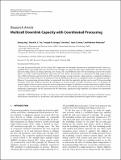| dc.contributor.author | Jing, Sheng | |
| dc.contributor.author | Tse, David N. C. | |
| dc.contributor.author | Soriaga, Joseph B. | |
| dc.contributor.author | Hou, Jilei | |
| dc.contributor.author | Smee, John E. | |
| dc.contributor.author | Padovani, Roberto | |
| dc.date.accessioned | 2011-12-02T18:06:08Z | |
| dc.date.available | 2011-12-02T18:06:08Z | |
| dc.date.issued | 2008-04 | |
| dc.date.submitted | 2008-01 | |
| dc.identifier.issn | 1687-1499 | |
| dc.identifier.issn | 1687-1472 | |
| dc.identifier.uri | http://hdl.handle.net/1721.1/67352 | |
| dc.description.abstract | Abstract We study the potential benefits of base-station (BS) cooperation for downlink transmission in multicell networks. Based on a modified Wyner-type model with users clustered at the cell-edges, we analyze the dirty-paper-coding (DPC) precoder and several linear precoding schemes, including cophasing, zero-forcing (ZF), and MMSE precoders. For the nonfading scenario with random phases, we obtain analytical performance expressions for each scheme. In particular, we characterize the high signal-to-noise ratio (SNR) performance gap between the DPC and ZF precoders in large networks, which indicates a singularity problem in certain network settings. Moreover, we demonstrate that the MMSE precoder does not completely resolve the singularity problem. However, by incorporating path gain fading, we numerically show that the singularity problem can be eased by linear precoding techniques aided with multiuser selection. By extending our network model to include cell-interior users, we determine the capacity regions of the two classes of users for various cooperative strategies. In addition to an outer bound and a baseline scheme, we also consider several locally cooperative transmission approaches. The resulting capacity regions show the tradeoff between the performance improvement and the requirement for BS cooperation, signal processing complexity, and channel state information at the transmitter (CSIT). | en_US |
| dc.publisher | Hindawi Publishing Corporation | en_US |
| dc.relation.isversionof | http://dx.doi.org/10.1155/2008/586878 | en_US |
| dc.title | Multicell Downlink Capacity with Coordinated Processing | en_US |
| dc.type | Article | en_US |
| dc.identifier.citation | Jing, Sheng et al. “Multicell Downlink Capacity with Coordinated Processing.” EURASIP Journal on Wireless Communications and Networking 2008 (2008): 1-19. Web. 2 Dec. 2011. © 2008 Sheng Jing et al. | en_US |
| dc.contributor.department | Massachusetts Institute of Technology. Laboratory for Information and Decision Systems | en_US |
| dc.contributor.approver | Jing, Sheng | |
| dc.contributor.mitauthor | Jing, Sheng | |
| dc.relation.journal | EURASIP Journal on Wireless Communications and Networking | en_US |
| dc.eprint.version | Author's final manuscript | en_US |
| dc.type.uri | http://purl.org/eprint/type/JournalArticle | en_US |
| eprint.status | http://purl.org/eprint/status/PeerReviewed | en_US |
| dc.date.updated | 2011-11-18T20:06:40Z | |
| dc.language.rfc3066 | en | |
| dc.rights.holder | et al.; licensee BioMed Central Ltd. | |
| dspace.orderedauthors | Jing, Sheng; Tse, David N. C.; Soriaga, Joseph B.; Hou, Jilei; Smee, John E.; Padovani, Roberto | en |
| mit.license | OPEN_ACCESS_POLICY | en_US |
| mit.metadata.status | Complete | |
